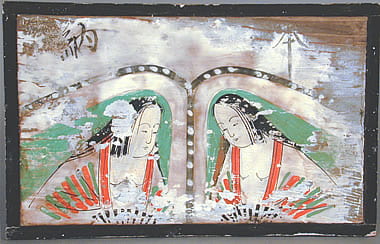The Religious Arts of Japan
May 4, 2007 – January 6, 2008
Historically, two major religions – Shinto and Buddhism – have existed harmoniously in Japan, playing complementary roles in its culture and giving rise to a rich variety of art forms.
For centuries, the Japanese have practiced rituals to honor and please the kami, the higher beings believed to inhabit the natural world and influence the weather, harvest, and our general well being. This religion, later named Shinto, originally had no imagery or art, but, under the influence of Buddhism, sculptures and paintings of kami were created (left), and Shinto shrines became more elaborate. Among the most intriguing Shinto art objects are the votive plaques known as ema, inscribed with prayers and then hung at shrines for the kami to read (below). When Buddhism arrived in Japan in the 6th century AD, it was already 1,000 years old and possessed a complex iconography and wide array of art forms. Soon, Japanese artists were sculpting elegant bronze and wooden Buddhist deities (left), printing Buddhist texts and images with woodblocks, and painting Buddhist scenes on silk as hangings to be worshipped in temples and homes.
This exhibition provides an introduction to these religions through some of the finest art works in the museum collection, many of which are being exhibited for the first time.
The Religious Arts of Japan is made possible in part by a grant from the Paul I. and Hisako Terasaki Center for Japanese Studies at UCLA. Programming in the new Gallery of Japanese Art is made possible through the ongoing support of Toshie and Frank Mosher, Nichi Bei Fujin Kai, and Setsuko Oka.
Meher McArthur
Guest Curator
Related Programs:
Guest Curator’s Tour
Saturday, May 19, 2pm, free w/admission
Tour of The Religious Arts of Japan
Artist’s Talk
Sunday, July 15, 1pm
Sumi Foley’s inventive reuse of vintage kimono fabrics can be seen in the Religious Arts of Japan exhibition, where her wall hanging, incorporating Shinto animal imagery, is on display. She will discuss that work, as well as its role in her ongoing series featuring Inari’s messenger, the fox. Takes place in the Gallery of Japanese Art. Free with admission
